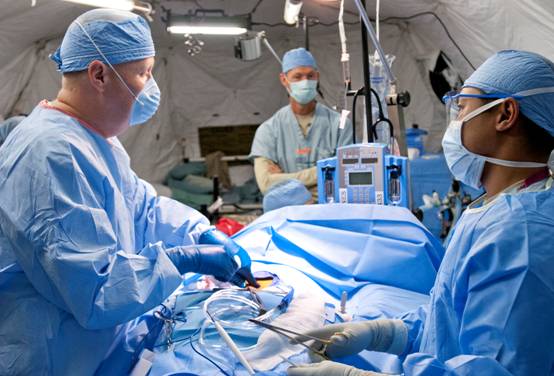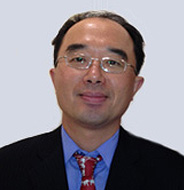|

Figure 1: Image in public domain
Article 24 of Taiwan's Patent Act lists as a statutory exclusion "diagnostic, therapeutic and surgical methods for the treatment of humans or animals". However, whether this means that inventors should not attempt to apply for a patent for medical techniques (medical procedures) solely on this basis is a matter which merits further consideration, as countries including the United States and Australia both allow for the patenting of medical techniques. As part of their international patent portfolios, Taiwanese hospitals and clinics can still apply for patents in the US and Australia, and after being granted the patent, license the techniques in those countries. Applying for a patent for a medical technique in Taiwan is significant therefore, as priority can be asserted in US and Australian applications, but this leads us back to the question of whether or not one can apply for a patent on a medical technique. This article is aimed at resolving this issue, and advocating that the Patent Act allows patent applications for inventions which cannot be granted patents.
Medical Techniques are 'Inventions' as Defined by the Patent Act
Article 21 of Taiwan's Patent Act defines an "invention" as "the creation of technical ideas, utilizing the laws of nature". Therefore, the concept of inventions as defined by the Patent Act includes operations and implementations. In the Patent Act, "inventions" are focused on creations, and these creations come from technical ideas and make use of laws of nature. So when examining whether or not medical techniques constitute "inventions" as defined in Article 21 of the Patent Act, one can look at it from three perspectives, "creation", "laws of nature" and "technical ideas".
In the dictionary of Taiwan's Ministry of Education, the Chinese word for "creation" has two definitions: "Create and make" and "specifically refers to original creations based on one's own ideas. It normally refers to the production of literary or artistic works". Therefore ""creation" can refer to the making of a concrete object (the first definition), or it can refer to the expression of a concept (the second definition), and the latter can include an operational method.
As to the interpretation of laws of nature, they can generally be taken to mean "rules that come about from non-manmade effects". "Nature" is used here in a relative sense, as the opposite of "manmade". However, "laws of nature" are also discovered and defined by humans, otherwise man would be unable to make use of them. Therefore "non-manmade effects" can be discovered or defined by humans, but the "rules" themselves shouldn't be brought about through human manipulation, but should rather be preexisting rules that are just exploited by humans, such as Newton's Laws of Motion, which are out of the control of humans.
As to the interpretation of "technical ideas", "technical" refers to "specialized skills"; then we can apply the meanings of "creation" as both referring to "matter" and "ideas", and adopt the latter to refer to "ways of thinking or concepts" or "the result of thinking or a mental process". Both of these definitions involve the workings of the human brain. Therefore "technical ideas" can be interpreted as "ideas relating to specialized skills", or "specialized technical objects conceived of by the workings of the human brain."
Therefore "inventions", as defined in Article 21 of the Patent Act, can be interpreted to mean "objects or expressions produced as a result of specialized technical thinking, where this thinking makes use of rules derived from non-man-made effects." "Inventions" require the working of the human brain, and must result from a base of specialized technical knowledge. An idea taken from a dream, under this logic, does not constitute an "invention", but stumbling upon an idea, and then after thinking about it and implementing it does. This "thinking" must include "rules derived from non-manmade effects. It can also be interpreted that there must be a reason for "creation”.
Under this definition, someone who qualifies as an inventor will not create an invention without reason. Inventions are not produced through some "supernatural" force. Inventions must involve the observation of phenomena. Even if the phenomenon does not follow known principles, it must have its basis in some form of specialized technical knowledge, as only then can the inventor confirm that that an innovative thing or idea has been produced.
Medical techniques, essentially still constitute inventions as defined in Article 21 of the Patent Act. Doctors or researchers observe human diseases or observe physiological processes, and the biological principles that underlie them. According to these principles, these doctors or researchers can come up with methods of diagnosis, treatments or surgical techniques. The process of coming up with "medical techniques" involves "rules resulting from non-manmade effects" at every step, as well as their categorization and implementation, and judgments based on specialized medical knowledge and clinical testing, therefore, it is my opinion that medical techniques are completely in line with the definition of "inventions" in Article 21 of the Patent Act.
'Non-patentable Inventions' vs. 'Rejected Patent Applications'
There are three conceptions of "inventions" in the Patent Act: "pre-application inventions", "inventions subject to patent applications" and "patentable inventions".
First of all, delimiting the concept of "pre-application invention" is necessary, as only then can one examine the ownership disputes before a patent application has been filed. According to Article 5 of the Patent Act, "the inventor" has the initial right to apply for a patent on the invention, but the Patent Act does not define how one is assigned inventorship. From the definition of inventor listed in Article 21, the inventor should engage in the "creation of technical ideas, utilizing the laws of nature." Another issue is what level of technical ideas constitutes inventive "creation". According to the judgment of the 2011 Administrative Lawsuit No. 115, heard by the Taiwan Intellectual Property Court, "the inventor must have a substantial contribution to the technical features listed in the scope of the patent, and 'a substantial contribution' refers to the creator acting as a driver in the completion and implementation of the invention, providing a concrete realizable technical method for a conception which can solve the problem the invention was designed to resolve or increased efficiency." If the creator of a "medical technique" provides a concrete and realizable technical method for it, it can be classified as a "pre-application invention".
"An invention subject to a patent application" indicates an invention as recorded in a patent application document, including the description, the claims, the abstract and the necessary drawings. These descriptions define the invention that the applicant is requesting the authorities to grant. This limits the applicant in the scope to which they can amend the patent after application. The recorded "scope of the patent application" is what is used by the court in establishing the ownership of the right to apply for a patent.
A "patentable invention" is an invention which has passed an examination determining its patentability. In a narrow sense, the criteria for patentability are referred to as substantive criteria for a patent, and refer to industrial applicability, novelty and the inclusion of an inventive step. Broader criteria are formalities criteria, including all the application materials listed in Article 25, the need to fulfill the sufficient disclosure principle as outlined in Article 26, the need for it to be a single invention, as outlined in Article 34, and being amended in accordance with Articles 43 and 44. In addition to this, Article 24 of the Patent Act states that three kinds of inventions that cannot be granted a patent, exceptions to patentability made in the public interest.
After coming to an understanding of the three concepts of "invention" in the Patent Act, we can then differentiate between "inventions which cannot be patented" and "rejected patent applications". Medical technique inventions only constitute "inventions which cannot be patented". So it is permissible under the Patent Act for an application to be filed with a medical technique as its subject matter. According to the first clause of Article 25, "A patent application for invention shall be filed with the Specific Patent Agency by the owner of the right to apply for a patent who is to provide an application form, a description, claim(s), an abstract, and the necessary drawing(s)." The second clause of the same article states, "The filing date of a patent application for invention shall be the date on which the application form, description, claim(s), and the necessary drawing(s) are provided in full." This means that once all the application materials have been filed, the documents become a legal patent application. When the application is not complete, according to the first clause of Article 17, the application will not be considered. As soon as the application documents are complete, the applicant must apply for a substantive examination, and the patent authority must engage in a substantive examination. Therefore, the legality of a patent application has no relation to the subject matter of the patent application. Even if the subject matter of a patent application is a medical technique, the application is still, legally speaking, a patent application.
The Patent Act does not limit "inventions" to "inventions that can be patented". And the concept of an "invention" in the Patent Act changes at every stage (pre-application invention, invention subject to patent application, invention subject to substantive examination etc.). "Medical techniques" can be inventions at the first and second stage, namely pre-application inventions and inventions subject to a patent application. In the Patent Act, applications for "inventions that can't be patented" will still be accepted as patent applications, so patent applications for medical techniques will still be processed as patent applications. Therefore they can be used as the basis for asserting priority, and can play an important role in building a global patent portfolio.
This article was translated from the original Chinese by Conor Stuart. Views expressed in this article are exclusively those of the author and do not necessarily reflect views of NAIP or any of its affiliates.
 |
|
| Author: |
Quincy Chen |
| Current Post: |
Assistant Professor, Graduate Institute of Technology, Innovation and Intellectual Property Management, National Chengchi University |
| Education: |
Assistant Professor, Graduate Institute of Intellectual Property, Taipei University of Technology;
Process Engineer, Winbond Electronics Corp.;
Process R&D Engineer, UMC;
Patent Engineer, Mosel Vitelic Inc.;
Patent Engineer, Yuteng International Intellectual Property;
Patent Engineer, VIA Technologies
Assistant Project Manager, Asian Pacific International Patent & Trademark Office。 |
| Experience: |
Juris Doctoris, Washington University in St. Louis;
LL.M. in Intellectual Property and Technology Law,
LL.M. in Intellectual Property and Technology Law, Washington University in St. Louis;
LL.M, Institute of Law and Inter-Disciplinary Studies, National Chengchi University;
Masters in Chemical Engineering, National Taiwan University |
|
|
|
| Facebook |
|
Follow the IP Observer on our FB Page |
|
|
|
|
|
|

